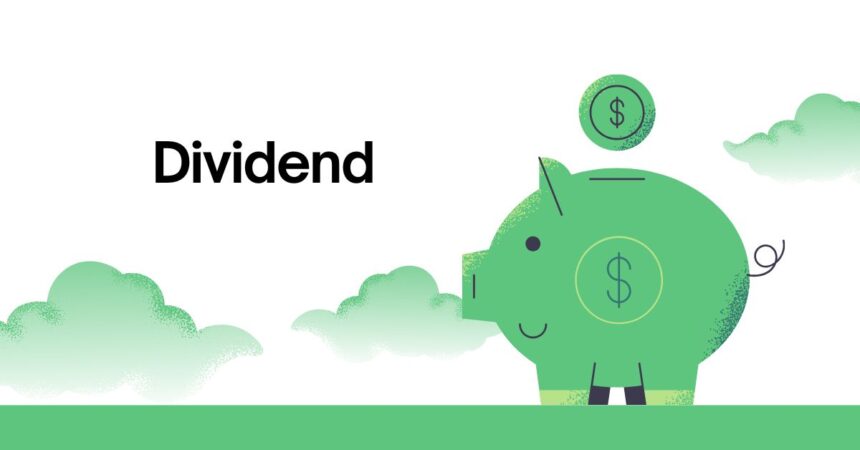A dividend is a payment made by a corporation to its shareholders, usually in the form of cash or additional shares. It represents a portion of the company’s profits that is distributed as a reward to investors for holding the company’s stock. Companies that pay dividends are often well-established with consistent earnings.
For example, if a company declares a $1 dividend per share and you own 100 shares, you’ll receive $100 in dividends.
Key Takeaways
- A dividend is a payment from a company’s profits to its shareholders.
- Dividends can be paid in cash, additional shares (stock dividends), or even property.
- Companies typically pay dividends quarterly, but some offer monthly or annual dividends.
- Example: If Apple declares a $0.50 dividend and you own 200 shares, you’ll receive $100.
Why Do Companies Pay Dividends?
- Reward Shareholders: A way to share profits with investors.
- Signal Financial Health: Regular dividends suggest strong, stable earnings.
- Attract Investors: Dividend-paying stocks appeal to income-focused investors, like retirees.
- Build Investor Confidence: Consistent dividends indicate good corporate governance and financial discipline.
Types of Dividends
- Cash Dividends:
- The most common type, paid directly into shareholders’ bank accounts or brokerage accounts.
- Example: A $1.50 per-share dividend for 1,000 shares = $1,500 cash payout.
- Stock Dividends:
- Instead of cash, companies issue additional shares to shareholders.
- Example: A 5% stock dividend means you receive 5 extra shares for every 100 shares owned.
- Property Dividends:
- Rarely used, companies distribute physical assets or securities of another company.
- Special Dividends:
- One-time payments made after exceptionally strong financial performance.
- Example: A company sells a large asset and distributes the profits as a special dividend.
- Scrip Dividends:
- Companies issue a promissory note to pay dividends at a later date, often due to short-term cash constraints.
- Liquidating Dividends:
- Paid when a company is closing down or liquidating its assets, returning capital to shareholders.
How Do Dividends Work?
Dividends follow a structured timeline:
- Declaration Date:
- The company’s board of directors announces the dividend, specifying the amount and payment date.
- Ex-Dividend Date:
- The cut-off date to be eligible for the dividend. If you buy the stock on or after this date, you won’t receive the dividend.
- Record Date:
- The date when the company reviews its records to determine who qualifies for the dividend.
- Payment Date:
- The date when the dividend is actually paid to shareholders.
Example of a Dividend Payment
- Company ABC declares a $2 per-share dividend.
- You own 500 shares.
- Dividend payout: 500 shares × $2 = $1,000.
If you bought the shares before the ex-dividend date, you’d receive the $1,000 on the payment date.
Benefits of Dividends
✅ Pros:
- Passive Income: Provides regular income without selling shares.
- Signal of Strength: Regular dividends indicate financial stability.
- Compounding Power: Reinvesting dividends can accelerate wealth growth.
- Cushion Against Market Volatility: Dividends provide returns even during market downturns.
❌ Cons:
- Taxable Income: Dividends may be subject to income tax, reducing net gains.
- Slower Growth: Companies paying high dividends may invest less in growth opportunities.
- Not Guaranteed: Companies can cut or eliminate dividends during tough economic times.
Dividend Example: Apple Inc. (AAPL)
Apple pays a quarterly dividend. If the current dividend is $0.24 per share:
- Owning 1,000 shares earns you $240 per quarter or $960 annually.
- If you reinvest these dividends, you buy more Apple shares, increasing your future dividend income.
Dividend Yield Formula
Dividend Yield=(Annual Dividend Per ShareShare Price)×100\text{Dividend Yield} = \left( \frac{\text{Annual Dividend Per Share}}{\text{Share Price}} \right) \times 100Dividend Yield=(Share PriceAnnual Dividend Per Share)×100
- Example:
- Annual Dividend: $4
- Share Price: $100
- Dividend Yield: (4/100)×100=4%(4/100) \times 100 = 4\%(4/100)×100=4%
Higher yields attract income-focused investors, but extremely high yields may signal financial distress.
Dividend Investing Strategies
- Dividend Growth Investing:
- Focus on companies with a history of consistently increasing dividends (e.g., Dividend Aristocrats).
- High-Yield Dividend Investing:
- Prioritize stocks with above-average dividend yields, often found in sectors like utilities and real estate (REITs).
- Dividend Reinvestment Plan (DRIP):
- Automatically reinvest dividends to purchase more shares, compounding growth over time.
- Income-Focused Portfolios:
- Ideal for retirees seeking steady cash flow from dividends without relying on stock price appreciation.
Dividend vs. Share Buybacks
- Dividends: Direct payments to shareholders.
- Share Buybacks: Companies purchase their own shares, reducing the number of shares in circulation and potentially increasing share value.
While both return value to shareholders, dividends offer immediate cash, while buybacks can boost long-term capital gains.
Risks Associated with Dividends
- Dividend Cuts: In economic downturns, companies may reduce or suspend dividends (e.g., many firms during COVID-19).
- Market Sensitivity: High-yield stocks can be sensitive to interest rate changes.
- Over-Reliance: Focusing solely on dividends may overlook growth opportunities in non-dividend-paying companies.
Dividends play a crucial role in long-term investing, offering regular income and the potential for compounding growth. While not guaranteed, they signal a company’s financial health and can cushion investors during market volatility. For income-focused investors, a well-diversified dividend portfolio can be a powerful tool for building wealth.





